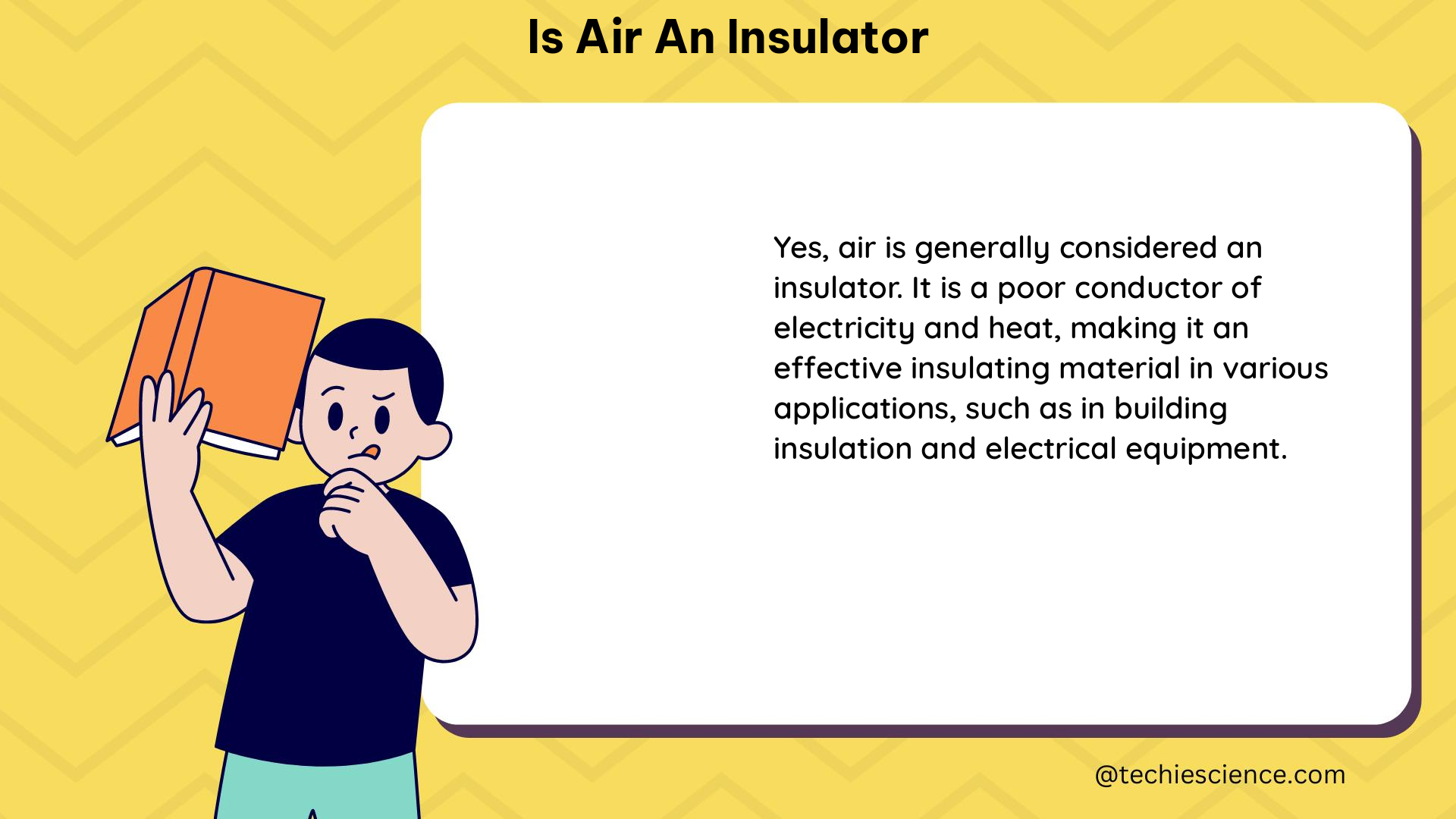Air is a remarkable substance that exhibits unique insulating properties due to its low density and the large distance between its molecules. This property makes air resistant to heat transfer, making it a valuable insulator in various applications. In this comprehensive guide, we will delve into the technical details and explore the physics behind why air is considered an insulator.
Understanding the Thermal Conductivity of Air
The thermal conductivity of a material is a measure of how well it conducts heat. The lower the thermal conductivity, the better the material is as an insulator. Air has a relatively low thermal conductivity, which is a key factor in its insulating capabilities.
The thermal conductivity of air at 0°C and 1 atmosphere of pressure is approximately 0.025 W/mK. This value is significantly lower compared to other materials, such as copper (401 W/mK) or aluminum (237 W/mK), which are excellent conductors of heat.
The low thermal conductivity of air is a result of its low density and the large distance between its molecules. As a gas, air has fewer molecules per unit volume compared to liquids or solids, and the large distance between these molecules makes it difficult for heat to transfer through the material.
Measuring the Insulating Properties of Air: R-value

Another way to quantify the insulating properties of air is by determining its R-value, which is a measure of a material’s resistance to heat flow. The R-value of a material is inversely proportional to its thermal conductivity, meaning that the higher the R-value, the better the insulating properties.
The R-value of air is approximately 0.68 m²K/W, which is relatively low compared to other insulating materials. For example, the R-value of fiberglass insulation can range from 2.2 to 4.3 m²K/W, depending on the thickness and density.
The low R-value of air is a result of its low density and the large distance between its molecules, which reduces the material’s ability to resist heat flow.
Air as an Electrical Insulator
In addition to its thermal insulating properties, air is also an excellent electrical insulator. The electrical conductivity of air is approximately 10^-15 S/m, which is extremely low compared to other materials.
This low electrical conductivity means that air is able to prevent the flow of electrical current, making it a valuable insulator in electrical applications. For example, air is commonly used as an insulator in high-voltage power lines, where it helps to prevent electrical arcing and ensure the safe transmission of electricity.
Applications of Air as an Insulator
Air’s insulating properties have led to its widespread use in various applications:
-
Double-Pane Windows: Double-pane windows consist of two sheets of glass with a small space of air or gas between them. This air space acts as an insulator, reducing the ability of heat to transfer through the window via convection, making the window more energy-efficient.
-
Insulated Coffee Cups: Insulated coffee cups are designed to keep hot drinks hot and cold drinks cold by trapping a layer of air between the inner and outer walls of the cup. This layer of air acts as an insulator, preventing heat from transferring through the cup and maintaining the desired temperature of the drink.
-
Thermal Insulation: Air is a key component in many types of thermal insulation, such as fiberglass, foam, and reflective insulation. The air pockets within these materials help to reduce the transfer of heat, making them effective insulators.
-
Electrical Insulation: As mentioned earlier, air’s low electrical conductivity makes it a valuable insulator in electrical applications, such as high-voltage power lines and electrical equipment.
-
Cryogenic Applications: Air’s insulating properties are also utilized in cryogenic applications, where it is used to insulate the storage and transportation of extremely cold liquids, such as liquid nitrogen and liquid helium.
Numerical Examples and Calculations
To further illustrate the insulating properties of air, let’s consider a few numerical examples and calculations:
- Thermal Conductivity Calculation:
- Given: Thermal conductivity of air at 0°C and 1 atmosphere = 0.025 W/mK
- Calculate the heat transfer rate through a 1 m² area of air with a temperature difference of 10°C and a thickness of 0.1 m.
- Heat transfer rate = (Thermal conductivity × Temperature difference) / Thickness
-
Heat transfer rate = (0.025 W/mK × 10°C) / 0.1 m = 2.5 W
-
R-value Calculation:
- Given: R-value of air = 0.68 m²K/W
- Calculate the heat transfer rate through a 2 m² area of air with a temperature difference of 15°C.
- Heat transfer rate = (Temperature difference) / (R-value × Area)
-
Heat transfer rate = (15°C) / (0.68 m²K/W × 2 m²) = 11.03 W
-
Electrical Conductivity Calculation:
- Given: Electrical conductivity of air ≈ 10^-15 S/m
- Calculate the resistance of a 1 m³ volume of air with a cross-sectional area of 0.5 m².
- Resistance = (Length) / (Electrical conductivity × Cross-sectional area)
- Resistance = (1 m) / (10^-15 S/m × 0.5 m²) = 2 × 10^15 Ω
These examples demonstrate the low thermal conductivity, high R-value, and extremely low electrical conductivity of air, which contribute to its excellent insulating properties.
Conclusion
In conclusion, air is an excellent insulator due to its low density and the large distance between its molecules. This property makes air resistant to heat transfer, which is quantified by its low thermal conductivity and high R-value. Additionally, air’s low electrical conductivity makes it a valuable insulator in electrical applications.
The insulating properties of air have led to its widespread use in various applications, such as double-pane windows, insulated coffee cups, thermal insulation, and cryogenic applications. By understanding the technical details and physics behind air’s insulating properties, physics students can gain a deeper appreciation for the versatility and importance of this ubiquitous substance.
References:
- Characteristics of Air as an Insulator
- Stay Warm with Thermal Insulation
- Is Air an Insulator?
- How Is Air an Insulator?
- Thermal Conductivity of Gases
- Electrical Conductivity of Air

Hi,
I am Megha B R, I have completed my Post-Graduation in Solid State Physics and pursuing B. Ed. I am a Physics enthusiast. As an Academic writer, my goal is to reach the readers in a simplified manner through my articles.
Let’s connect through LinkedIn-